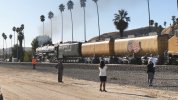We are all familiar with steam locos topping up their water supply en route either by chucking a water column outlet into the tank or tender at a station stop or by use of water troughs.
Has en route coaling ever been used in the UK or elsewhere?
I know there have been cases of locos having either to be replaced or visiting a nearby loco shed for a top up on rare occasions (when the first batch of Britannias went to Holyhead they struggled the 263 miles to Euston and were eventually replaced by later locos with larger coal capacity tenders).
Of course coal is a very different substance to water but some means of depositing a ton or two of coal might be practical?
Has en route coaling ever been used in the UK or elsewhere?
I know there have been cases of locos having either to be replaced or visiting a nearby loco shed for a top up on rare occasions (when the first batch of Britannias went to Holyhead they struggled the 263 miles to Euston and were eventually replaced by later locos with larger coal capacity tenders).
Of course coal is a very different substance to water but some means of depositing a ton or two of coal might be practical?



